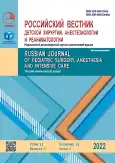Comparative assessment of the predictive ability of the nSOFA and NEOMOD scales in preterm newborns
- Authors: Idrisova R.G.1, Amirova V.R.1,2, Mironov P.I.2, Lekmanov A.U.3,4
-
Affiliations:
- Republic Perinatal Hospital
- Bashkir State Medical University
- Veltishchev Research Clinical Institute for Pediatrics and Pediatric Surgery
- Pirogov Russian National Research Medical University
- Issue: Vol 12, No 3 (2022)
- Pages: 351-359
- Section: Original Study Articles
- URL: https://journals.rcsi.science/2219-4061/article/view/123627
- DOI: https://doi.org/10.17816/psaic1278
- ID: 123627
Cite item
Full Text
Abstract
BACKGROUND: A life-threatening organ dysfunction is a strong predictor of in-hospital mortality and adverse outcomes in pediatric patients and full-term neonates. Predictors of outcomes of multiple-organ failure in preterm newborns have not yet been sufficiently determined.
AIM: To compare the discriminatory ability of neonatal sequential organ failure (nSOFA) and NEOMOD organ dysfunction scales as predictors of poor outcomes in very preterm newborns.
MATERIALS AND METHODS: This prospective observational study included 109 newborns with a birth weight of 1071 (772–1451) g and gestational age of 29 (26–32) weeks; 22 (20.4%) of them died.
RESULTS: The area under the receiver operating characteristic curve was 0.796 (95% confidence interval (CI) 0.763–0.827) for the nSOFA scale and 0.771 (95% CI 0.721–0.817) for the NEOMOD scale.
CONCLUSIONS. Both scales are suitable for measuring the severity of organ dysfunction in preterm newborns. nSOFA appears to predict mortality in preterm newborns.
Full Text
##article.viewOnOriginalSite##About the authors
Rozaliya G. Idrisova
Republic Perinatal Hospital
Email: rosa.idrisova2016@yandex.ru
ORCID iD: 0000-0002-6825-2293
Head of Intensive Care Department
Russian Federation, UfaViktoria R. Amirova
Republic Perinatal Hospital; Bashkir State Medical University
Email: victoria_amirova@mail.ru
ORCID iD: 0000-0001-8693-9526
Dr. Sci. (Med.), Professor of the Department of Hospital Pediatrics
Russian Federation, Ufa; UfaPetr I. Mironov
Bashkir State Medical University
Email: mironovpi@mail.ru
ORCID iD: 0000-0002-9016-9461
SPIN-code: 5617-6616
Dr. Sci. (Med.), Professor of the Department of anesthesiology
Russian Federation, UfaAndrei U. Lekmanov
Veltishchev Research Clinical Institute for Pediatrics and Pediatric Surgery; Pirogov Russian National Research Medical University
Author for correspondence.
Email: aulek@rambler.ru
ORCID iD: 0000-0003-0798-1625
SPIN-code: 3630-5061
Dr. Sci. (Med.), Professor, Chief Researcher of the Department of Children’s Surgery
Russian Federation, MoscowReferences
- Ivanov DO, Avrel’kina EV, Aleksandrovich YuS, et al. Rukovodstvo po perinatologii. In 2 vol. Vol. 1. Saint Petersburg, 2019. 1592 c.
- Liu L, Johnson HL, Cousens S, et al. Global, regional, and national causes of child mortality: an updated systematic analysis for 2010 with time trends since 2000. Lancet. 2012;379(9832):2151–2161. doi: 10.1016/S0140-6736(12)60560-1
- Ambalavanan N, Carlo WA, Tyson JE, et al. Generic Database; Subcommittees of the Eunice Kennedy Shriver National Institute of Child Health and Human Development Neonatal Research Network. Outcome trajectories in extremely preterm infants. Pediatrics. 2012;130(1):e115–e125. doi: 10.1542/peds.2011-3693
- Houweling TAJ, van Klaveren D, Das S, et al. A prediction model for neonatal mortality in low- and middle-income countries: an analysis of data from population surveillance sites in India, Nepal and Bangladesh. Int J Epidemiol. 2019;48(1):186–198. doi: 10.1093/ije/dyy194
- Lekmanov AU, Mironov GI, Alexandrovich YuS, et all. Sepsis in children: federal clinical guideline (Draft). Russian Journal of Pediatric Surgery, Anesthesia and Intensive Care. 2021;(2):241–292. doi: 10.17816/psaic969
- Matics TJ, Sanchez-Pinto LN. Adaptation and Validation of a Pediatric Sequential Organ Failure Assessment Score and Evaluation of the Sepsis-3 Definitions in Critically Ill Children. JAMA Pediatr. 2017;171(10):e172352. doi: 10.1001/jamapediatrics.2017.2352
- Garg B, Sharma D, Farahbakhsh N. Assessment of sickness severity of illness in neonates: Review of various neonatal illness scoring systems. J Matern Neonatal Med. 2017;31(10):1373–1380. doi: 10.1080/14767058.2017.1315665
- Serebryakova EN, Volosnikov DK. Prognostic significance of snappe ii, crib ii, neomod scales in relation to the risk of death in newborns with multiple organ dysfunction syndrome. Difficult Patient. 2016;(8–9):19–22. (In Russ.)
- Wynn JL, Polin RA. A neonatal sequential organ failure assessment score predicts mortality to late-onset sepsis in preterm very low birth weight infants. Pediatric Res. 2019;88(1):85–90. doi: 10.1038/s41390-019-0517-2
- Mironov PI, Lekmanov АU. Evaluation of the validity of the nSOFA score in newborns with sepsis. Messenger of Anesthesiology and Resuscitation. 2021;18(2):56–61. (In Russ.) doi: 10.21292/2078-5658-2021-18-2-56-61
- Fleiss N, Coggins SA, Lewis AN, et al. Evaluation of the neonatal sequential organ failure assessment and mortality risk in preterm infants with late-onset infection. JAMA Network Open. 2021;4(2):e2036518. doi: 10.1001/jamanetworkopen.2020.36518
- Lewis AN, de la Cruz D, Wynn JL, et al. Evaluation of the neonatal sequential organ failure assessment and mortality risk in preterm infants with necrotizing enterocolitis. Neonatology. 2022;119(3):334–344. doi: 10.1159/000522560
- Management of newborns with respiratory distress syndrome. Guidelines edited by Academician of the Russian Academy of Medical Sciences N.N. Volodin. Neonatology: news, opinions, training. 2014. No. 1(3). Р. 129–144.
- Sweet DG, Carnielli V, Greisen G, et al. European Consensus Guidelines on the Management of Neonatal Respiratory Distress Syndrome in Preterm Infants — 2013 Update. Neonatology. 2019;115(4):432–450. doi: 10.1159/000499361
- Berka I, Kořcek P, Janota J, et al. Neonatal Sequential Organ Failure Assessment (nSOFA) Score within 72 hours after birth reliably predicts mortality and serious morbidity in very preterm infants. Diagnostics. 2022;12(6):1342. DOI. 10.3390/ diagnostics12061342
Supplementary files








